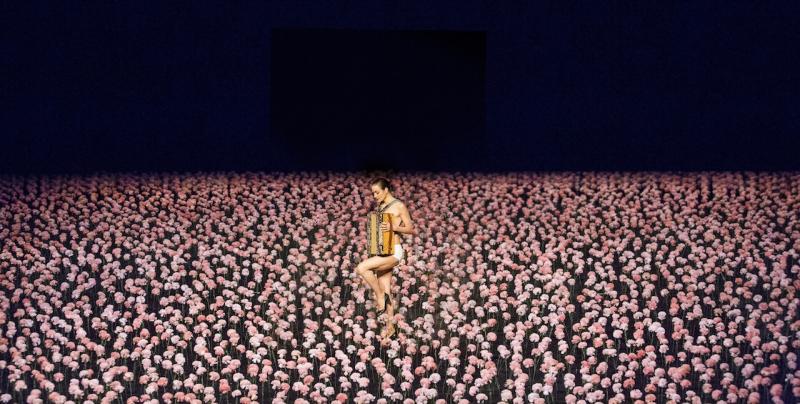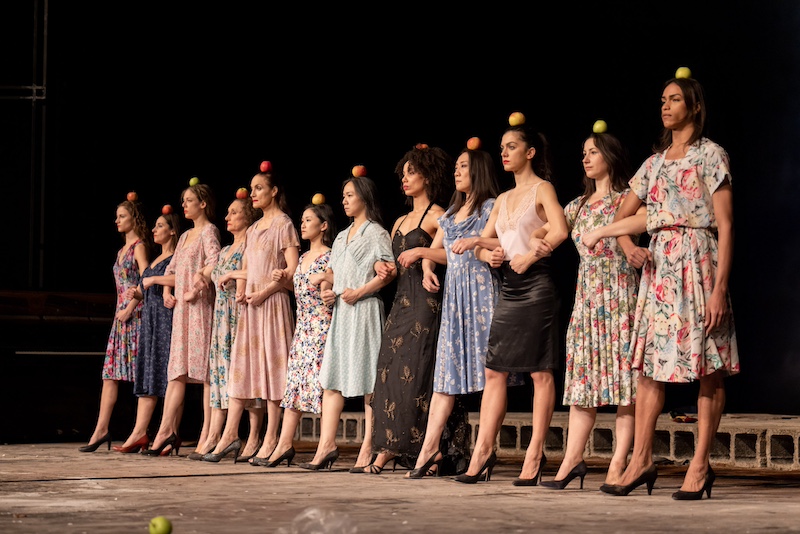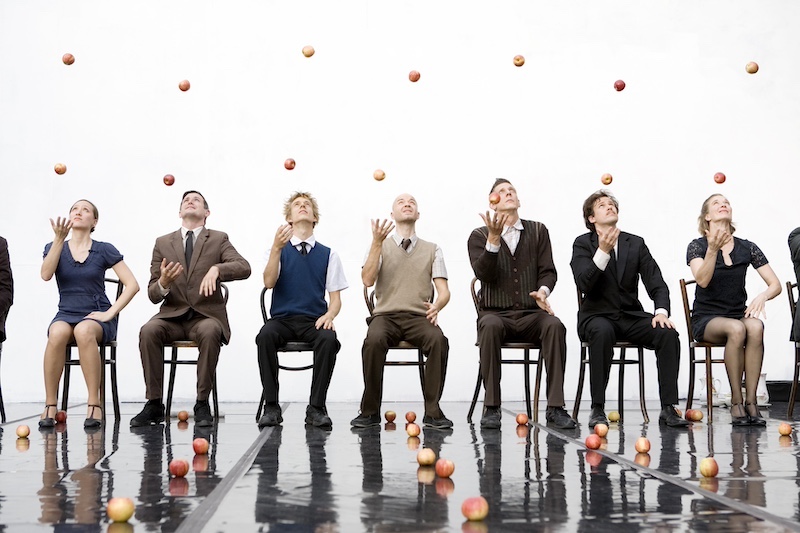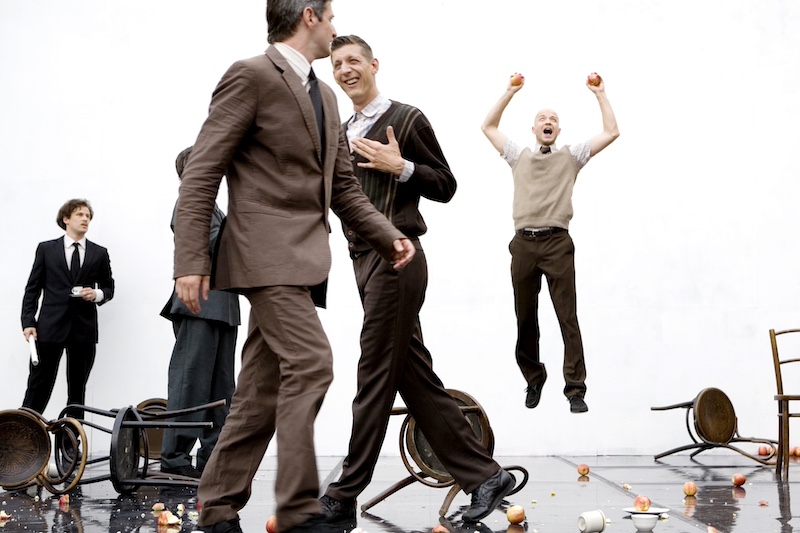First Person: pioneering juggler Sean Gandini reflects on how the spirit of Pina Bausch has infiltrated his work | reviews, news & interviews
First Person: pioneering juggler Sean Gandini reflects on how the spirit of Pina Bausch has infiltrated his work
First Person: pioneering juggler Sean Gandini reflects on how the spirit of Pina Bausch has infiltrated his work
As Tanztheater Wuppertal Pina Bausch's 'Nelken' comes to Sadler’s Wells, a tribute from across the art forms

I am a juggler. My wife Kati Ylä-Hokkala is also a juggler. Our life for the last three decades has been juggling. We have been fortunate to be practising this art form at a time when mathematical and creative developments meant that our vocabulary went from about 30 patterns to thousands. The Golden Age of juggling.
In 2010 our lovely patron Angus MacKechnie asked us to put together a new piece for the outdoor space outside London's National Theatre. The late great Pina Bausch had just died and we decided to make a one-off tribute to her. We made a piece called Smashed. I had been intrigued for a number of years as to whether one could make a juggling parade which emanated from the Bausch universe. That year also was an Isaac Newton anniversary and we had used giant apples in the Paralympic opening ceremony so we decided to use apples as the main props in the piece. The apple choice was not related to Pina and we only later found out she had used them and thrown them in her show Palermo Palermo (pictured below). Our intention had been to reference other aspects of her work – the suits, the dresses, the power games – as well as the humour and the absurdity. I always loved how there is no obvious moral judgement in her pieces: she depicts humans as complex and perhaps sad, yearning for a love that seems to be elusive. Negotiating the work of such an iconoclastic creator runs the risk of ridicule and parody. There is a thin line between tribute and mockery. Since we did not think our piece would have a further life, we made it rather insouciantly and quickly. The irony, now that Smashed is to be revived later this year at the Peacock Theatre, is that I know so much more about Pina now than I did then.
Our intention had been to reference other aspects of her work – the suits, the dresses, the power games – as well as the humour and the absurdity. I always loved how there is no obvious moral judgement in her pieces: she depicts humans as complex and perhaps sad, yearning for a love that seems to be elusive. Negotiating the work of such an iconoclastic creator runs the risk of ridicule and parody. There is a thin line between tribute and mockery. Since we did not think our piece would have a further life, we made it rather insouciantly and quickly. The irony, now that Smashed is to be revived later this year at the Peacock Theatre, is that I know so much more about Pina now than I did then.
There is a saying in our company that whatever you decide to do, Pina Bausch or Merce Cunningham did it first. A Pina enthusiast wrote an analysis of our piece finding about 40 references to her work, most of which I knew nothing about! The show became a hit for us, and for the next decade we performed it almost 1000 times across the globe. We are delighted to bring it back to London again this spring. In London it feels foreign but in France where it gets performed often it is frequently described as “So British!”. Whilst performing the show outdoors in Paris I noticed a man in the audience whom I immediately recognised as Pina’s long-time collaborator Dominique Mercy. My body went into panic, what if he didn't like what we were doing, what if he found it disrespectful…? But as the show went on I could see him smiling. Afterwards he came to talk to us and was immensely generous. He accepted to come and be our outside eyes on a remix of the show (pictured below) that we performed for the 40th anniversary of the London International Mime Festival. We are now very excited finally to be seeing Nelken ("Carnations") at Sadler’s Wells. It’s one of the major pieces of Pina's which we have never seen live, and I will probably cry. This dialogue with the Bausch legacy made a great impact on us and our company Gandini Juggling. It cemented an acceptance of theatricality. We had spent the 1990s collaborating with the much-missed dance artist Gill Clarke, making a series of what I would retrospectively call formalist pieces. Influenced by North American postmodern dance, we were stubbornly anti-narrative, anti-theatre. We naively believed that juggling and the dance that ensues from it should be enough. Pina’s world was like a vehicle towards creative freedom. Which leads me to High Art Low Art! Juggling has a curious place, if any place at all, in the hierarchy of the arts. Part of our mission has been to share our enthusiasm for how versatile and beautiful It can be.
This dialogue with the Bausch legacy made a great impact on us and our company Gandini Juggling. It cemented an acceptance of theatricality. We had spent the 1990s collaborating with the much-missed dance artist Gill Clarke, making a series of what I would retrospectively call formalist pieces. Influenced by North American postmodern dance, we were stubbornly anti-narrative, anti-theatre. We naively believed that juggling and the dance that ensues from it should be enough. Pina’s world was like a vehicle towards creative freedom. Which leads me to High Art Low Art! Juggling has a curious place, if any place at all, in the hierarchy of the arts. Part of our mission has been to share our enthusiasm for how versatile and beautiful It can be.
We have been lucky to have made pieces which dialogue with both ballet and opera. Our 2013 piece 4 x 4 Ephemeral Architectures sent ballet and juggling on a Tinder date, imagining that juggling is imbued with the same classism that we all associate with ballet. It has always amused me to think that if Louis XIV had adored juggling instead of dancing our world might be filled with juggling houses and ballerinas would gather in the public squares of the world setting fire to their pointe shoes. At the time the Royal Ballet offered us access to their divine studios overlooking the Covent Garden piazza. I enjoyed the irony that a couple of decades earlier I had started my juggling career on the hallowed stones of that very piazza. This led to a whole series of Tinder dates between juggling and dance!
 Exploring the borderline between the various performing art forms was an inspiration – discovering the watermark that one art form can leave on another, transferring the filigree from one skillset to another, layering, merging and also repulsing. Our relationship with opera was cemented in the Olivier award-winning Philip Glass opera Akhnaten, for English National Opera. Director Phelim McDermot asked us to choreograph 10 jugglers who are on stage for most of the production. Here our juggling takes on a very different role to anything else we have ever done, supplying a meta-narrative, sometimes illustrating the music, sometimes alluding to the story. Akhnaten has been one of the most successful operatic stagings in recent times with 50 performances so far.
Exploring the borderline between the various performing art forms was an inspiration – discovering the watermark that one art form can leave on another, transferring the filigree from one skillset to another, layering, merging and also repulsing. Our relationship with opera was cemented in the Olivier award-winning Philip Glass opera Akhnaten, for English National Opera. Director Phelim McDermot asked us to choreograph 10 jugglers who are on stage for most of the production. Here our juggling takes on a very different role to anything else we have ever done, supplying a meta-narrative, sometimes illustrating the music, sometimes alluding to the story. Akhnaten has been one of the most successful operatic stagings in recent times with 50 performances so far.
Our most recent piece LIFE was a love letter to Merce Cunningham, that other late, great choreographer whose death occured within four weeks of that of Pina Bausch. Both Kati and I have had a long-time fascination, dare I say obsession, with Merce's work, finding a kind of intellectual solace in it. We even travelled to New York to see the company’s final performances in 2011. The Cunningham Trust generously gave us access to their archives and we spent lockdown obsessively watching a multitude of pieces. Our most recent show contains references to about 30 Cunningham pieces, which isn't that many considering the 80 he made. It felt like coming full circle to our formalist roots but instead of rejecting theatre we now celebrate the way dance and juggling can hint at stories in a non-verbal language.
It’s vertiginous to stand on the shoulders of such giant artistic figures, but I guess making any kind of art requires a certain amount of delusion, or one would be crushed by the greatness of the past. There is also something quite soothing about our main art being juggling. As Kati sometimes says to me if I am stressed, WE JUST THROW THINGS IN THE AIR…
Explore topics
Share this article
The future of Arts Journalism
You can stop theartsdesk.com closing!
We urgently need financing to survive. Our fundraising drive has thus far raised £49,000 but we need to reach £100,000 or we will be forced to close. Please contribute here: https://gofund.me/c3f6033d
And if you can forward this information to anyone who might assist, we’d be grateful.

Subscribe to theartsdesk.com
Thank you for continuing to read our work on theartsdesk.com. For unlimited access to every article in its entirety, including our archive of more than 15,000 pieces, we're asking for £5 per month or £40 per year. We feel it's a very good deal, and hope you do too.
To take a subscription now simply click here.
And if you're looking for that extra gift for a friend or family member, why not treat them to a theartsdesk.com gift subscription?
more Dance
 'We are bowled over!' Thank you for your messages of love and support
Much-appreciated words of commendation from readers and the cultural community
'We are bowled over!' Thank you for your messages of love and support
Much-appreciated words of commendation from readers and the cultural community
 R:Evolution, English National Ballet, Sadler's Wells review - a vibrant survey of ballet in four acts
ENB set the bar high with this mixed bill, but they meet its challenges thrillingly
R:Evolution, English National Ballet, Sadler's Wells review - a vibrant survey of ballet in four acts
ENB set the bar high with this mixed bill, but they meet its challenges thrillingly
 Like Water for Chocolate, Royal Ballet review - splendid dancing and sets, but there's too much plot
Christopher Wheeldon's version looks great but is too muddling to connect with fully
Like Water for Chocolate, Royal Ballet review - splendid dancing and sets, but there's too much plot
Christopher Wheeldon's version looks great but is too muddling to connect with fully
 iD-Reloaded, Cirque Éloize, Marlowe Theatre, Canterbury review - attitude, energy and invention
A riotous blend of urban dance music, hip hop and contemporary circus
iD-Reloaded, Cirque Éloize, Marlowe Theatre, Canterbury review - attitude, energy and invention
A riotous blend of urban dance music, hip hop and contemporary circus
 How to be a Dancer in 72,000 Easy Lessons, Teaċ Daṁsa review - a riveting account of a life in dance
Michael Keegan-Dolan's unique hybrid of physical theatre and comic monologue
How to be a Dancer in 72,000 Easy Lessons, Teaċ Daṁsa review - a riveting account of a life in dance
Michael Keegan-Dolan's unique hybrid of physical theatre and comic monologue
 A Single Man, Linbury Theatre review - an anatomy of melancholy, with breaks in the clouds
Ed Watson and Jonathan Goddard are extraordinary in Jonathan Watkins' dance theatre adaptation of Isherwood's novel
A Single Man, Linbury Theatre review - an anatomy of melancholy, with breaks in the clouds
Ed Watson and Jonathan Goddard are extraordinary in Jonathan Watkins' dance theatre adaptation of Isherwood's novel
 Peaky Blinders: The Redemption of Thomas Shelby, Rambert, Sadler's Wells review - exciting dancing, if you can see it
Six TV series reduced to 100 minutes' dance time doesn't quite compute
Peaky Blinders: The Redemption of Thomas Shelby, Rambert, Sadler's Wells review - exciting dancing, if you can see it
Six TV series reduced to 100 minutes' dance time doesn't quite compute
 Giselle, National Ballet of Japan review - return of a classic, refreshed and impeccably danced
First visit by Miyako Yoshida's company leaves you wanting more
Giselle, National Ballet of Japan review - return of a classic, refreshed and impeccably danced
First visit by Miyako Yoshida's company leaves you wanting more
 Quadrophenia, Sadler's Wells review - missed opportunity to give new stage life to a Who classic
The brilliant cast need a tighter score and a stronger narrative
Quadrophenia, Sadler's Wells review - missed opportunity to give new stage life to a Who classic
The brilliant cast need a tighter score and a stronger narrative
 The Midnight Bell, Sadler's Wells review - a first reprise for one of Matthew Bourne's most compelling shows to date
The after-hours lives of the sad and lonely are drawn with compassion, originality and skill
The Midnight Bell, Sadler's Wells review - a first reprise for one of Matthew Bourne's most compelling shows to date
The after-hours lives of the sad and lonely are drawn with compassion, originality and skill
 Ballet to Broadway: Wheeldon Works, Royal Ballet review - the impressive range and reach of Christopher Wheeldon's craft
The title says it: as dancemaker, as creative magnet, the man clearly works his socks off
Ballet to Broadway: Wheeldon Works, Royal Ballet review - the impressive range and reach of Christopher Wheeldon's craft
The title says it: as dancemaker, as creative magnet, the man clearly works his socks off
 The Forsythe Programme, English National Ballet review - brains, beauty and bravura
Once again the veteran choreographer and maverick William Forsythe raises ENB's game
The Forsythe Programme, English National Ballet review - brains, beauty and bravura
Once again the veteran choreographer and maverick William Forsythe raises ENB's game

Add comment